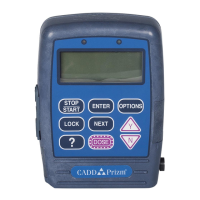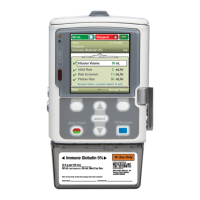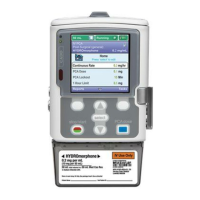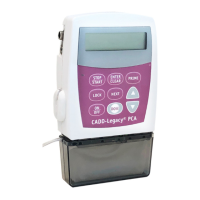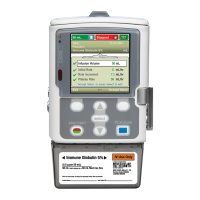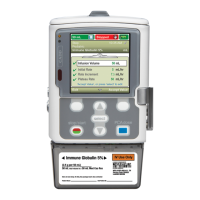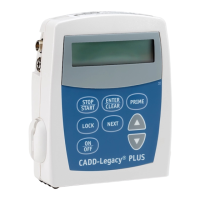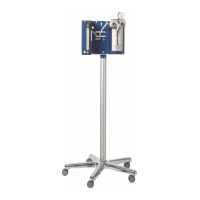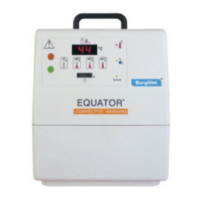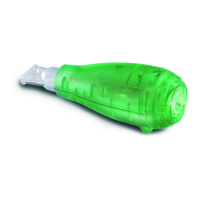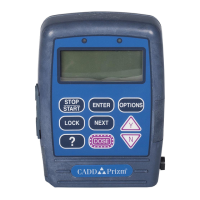
Do you have a question about the Smiths Medical CADD-Prizm VIP 6100 and is the answer not in the manual?
| Device Type | Infusion Pump |
|---|---|
| Manufacturer | Smiths Medical |
| Model | CADD-Prizm VIP 6100 |
| Battery Type | Lithium-ion |
| Display | LCD |
| Power Source | Rechargeable battery or AC adapter |
| Infusion Modes | Continuous, Intermittent, PCA |
| Flow Rate Range | 0.1 to 999 mL/hr |
| Alarm Types | Occlusion, Air-in-line, Low Battery |
| Programming Interface | Keypad and LCD screen |
| Rate Range | 0.1 to 999 mL/hr |
| Compatibility | CADD administration sets |
| Reservoir Capacity | 100 mL |
Overview of the CADD-Prizm® VIP ambulatory drug delivery pump.
Guidelines for administering drugs to the epidural or subarachnoid space.
Explains the function of the pump's indicator lights.
Describes the pump display and its power/data jacks.
Details the cassette attachment and polemount bracket recess.
Explains the function of each button on the pump keypad.
Details how the NEXT button navigates through screens.
Explains the DOSE button's function in PCA delivery.
Describes accessing the options menu with the OPTIONS button.
Explains the use of Y and N buttons for choices.
Recommends battery types and lists critical warnings for installation.
Step-by-step instructions for replacing the pump's battery.
Displays information for the PCA delivery mode main screen.
Displays information for the Continuous delivery mode main screen.
Displays information for the TPN delivery mode main screen.
Displays information for the Intermittent delivery mode main screen.
How to view and move between help screens using the ? key.
Procedures for exiting help screens and returning to the original screen.
Explains how lock levels affect available help information.
Details features accessible in each lock level for operations and programming.
Outlines feature access within the Options menu per lock level.
How to start the process of changing the pump's lock level.
Steps to choose and set the desired lock level (LL1 or LL2).
Finalizing the lock level change and verifying the setting.
Lists the four available delivery modes: PCA, CONTIN, TPN, INTERMT.
Step-by-step instructions to switch between delivery modes.
How to initiate pump operation and begin fluid delivery.
Procedures for halting pump operation and delivery.
Describes continuous rate, demand dose, and clinician bolus delivery.
Illustrates the sequence of screens for PCA programming.
How to enter the volume of fluid in the reservoir.
How to select units such as milligrams or milliliters.
Procedure for inputting the drug concentration.
Steps to set the hourly drug delivery rate.
How to program the amount for patient-activated doses.
Procedure for setting the time between patient-demand doses.
How to limit the number of doses allowed in one hour.
Procedure to reset the counters for given and attempted doses.
Resets the total amount of drug delivered.
Checks the status of the air detector if installed.
Option to add a marker to the event log.
How to review and potentially reprogram settings.
Setting maximum values for rate/dose in Lock Level 0.
How to adjust rate or dose within LL1 after LL0 limits are set.
Procedure for administering a clinician-activated bolus dose.
How a patient initiates a demand dose.
Procedure to stop a patient-initiated demand dose.
Procedure to stop a clinician-initiated bolus dose.
Visual representation of continuous drug delivery over time.
Overview of the screens used for programming continuous delivery.
How to enter the reservoir volume for continuous delivery.
Procedure for setting the hourly drug delivery rate.
Resets the total amount of drug delivered in continuous mode.
Checks the status of the air detector for continuous delivery.
How to review and potentially reprogram continuous delivery settings.
Setting maximum continuous rate in Lock Level 0.
How to adjust the continuous rate within LL1.
Visualizes the TPN infusion profile with taper periods.
Overview of screens for programming TPN delivery.
How to enter the reservoir volume for TPN.
Procedure for setting the total volume to be delivered.
Procedure for setting the total duration of the infusion.
How to program the gradual increase and decrease phases.
Displays the plateau and KVO rates for review.
Resets the total delivered volume for TPN.
Checks the status of the air detector for TPN delivery.
How to review and potentially reprogram TPN settings.
Importance of resetting reservoir volume before starting infusion.
How resetting reservoir volume also resets the infusion profile.
Visualizes intermittent drug delivery with doses and durations.
Overview of screens for programming intermittent delivery.
How to enter the reservoir volume for intermittent delivery.
Procedure for setting the volume of each intermittent dose.
How to set the time over which each dose is delivered.
Procedure for setting the time between the start of doses.
How to set the Keep Vein Open rate for patency.
Procedure for setting the date and time for the next dose.
Review calculated dose rate and reset delivered volume.
Checks the status of the air detector for intermittent delivery.
How to review and potentially reprogram intermittent settings.
Explains that stopping during KVO does not affect subsequent doses.
Details how stopping during a dose shifts subsequent doses.
Recommendations for making up lost time after stopping a dose.
How to view remaining time in the current dose and cycle.
Procedure for resetting or changing the next dose start time.
How to restart delivery of a dose that was stopped.
Step-by-step guide for detaching a used reservoir or administration set.
Lists compatible medication cassette reservoirs and administration sets.
Overview of subsequent procedures like priming and starting.
Step-by-step guide to physically attach the reservoir/set.
How to lock the cassette and pump into place.
Procedure for confirming reservoir volume reset.
How to reset the infusion profile in TPN mode.
How to prime the tubing before connecting to the patient.
Steps for connecting the primed tubing to the patient.
How to thread tubing through the air detector if used.
Procedures to ensure the fluid path is free of air bubbles.
Steps to start the reservoir volume reset process.
How to reset the infusion profile when in TPN mode.
Explains the purpose and availability of pump options.
Step-by-step guide on how to navigate and select options.
Option to stop TPN infusion early by tapering down.
How to prime the fluid path to remove air bubbles.
How to view remaining time in intermittent delivery.
Describes viewing past 48 hours of PCA dose information.
Summary view of current settings and dose history.
Detailed view of doses given/attempted per hour.
Final steps for reviewing PCA extended history data.
Information on switching between PCA, CONTIN, TPN, INTERMT modes.
How AutoLock automatically changes pump lock levels.
How to view and set the pump's internal clock time.
How to view and set the pump's current date.
How to turn the air detector on or off.
How to access and review the pump's event log.
Information on the discontinued remote connection option.
How to use the toolbox for pump configuration and customization.
How to print reports using CADD-Sentry® safety software.
Information on using external power sources for the pump.
Steps for connecting and disconnecting power adapters.
Function and precautions for using the remote dose cord.
Description of pouches for carrying and protecting the pump.
How the security shell prevents unauthorized access to medication.
How to place the IV bag or syringe holder in the shell.
Steps for mounting the pump onto the security shell.
How to lock and unlock the pump within the security shell.
How to attach the pump or security shell to an IV pole.
Steps to mount the pump or shell onto the bracket.
Steps to detach the pump or shell from the bracket.
A list of pump messages and their corrective actions.
Corrective actions for AutoLock, Cassette Not Attached, Cassette Unlocked errors.
How to handle detected errors and high pressure conditions.
Information on using compatible administration sets.
Actions for depleted power packs and upcoming maintenance.
Explains 'Range Limited' messages and low/zero reservoir volume.
Corrective actions for upstream occlusion and wrong cassette detection.
